- Home
- About Us
- Programs
- Being Here
- FAQs
- Resources
- News
- Links
- Support Us
Dec

Throughout 2009, we kept records of our courses and the students who took part in them. After doing a little analysis of this information, we put together some details that we thought may be of interest to students and visitors past, present and future.
Here at Tushita, we are using some of these statistics to inform upcoming decisions in relation to course programming and improvements to the centre, with the aim of continuing to provide a conducive environment for those who wish to learn more about Buddha Dharma. We hope that you will find the following information clear and pleasing to the eye, and that we will see you up here on the blessed hill in the future.
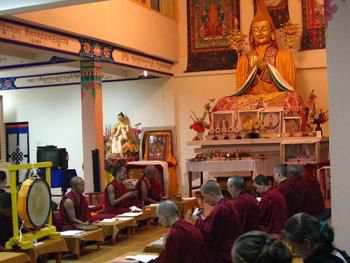
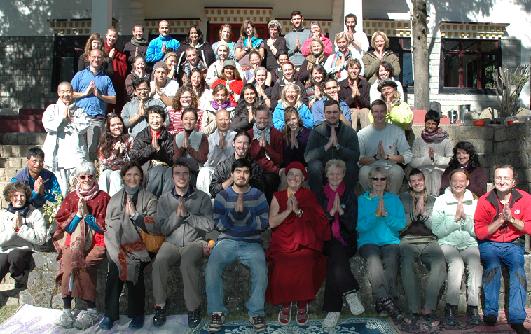
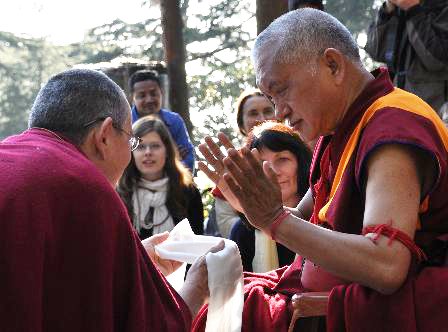
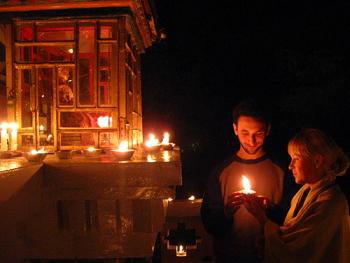
2009 Overview
Our 2009 season ran from February to November, and in those 10 months we held a total of 38 courses and retreats – not too shabby!
| COURSE | NUMBER |
| Introduction to Buddhism Courses | 15 |
| Intermediate Level Courses | 8 |
| Non-Residential Courses | 6 |
| 5-day Residential How to Meditate Courses | 4 |
| Tantric Retreats | 4 |
| Pre-Ordination Course | 1 |
| TOTAL | 38 |
For the first time, Tushita ran courses consecutively; Short & Intermediate Level Courses and Tantric retreats alongside our staple 10-day “Introduction to Buddhism” courses. Sometimes we had courses going on in each of our 3 Meditation Halls at the same time! It’s safe to say that 2009 was our busiest year so far.
Here’s an illustration of how our calendar ran throughout the 10-month season:
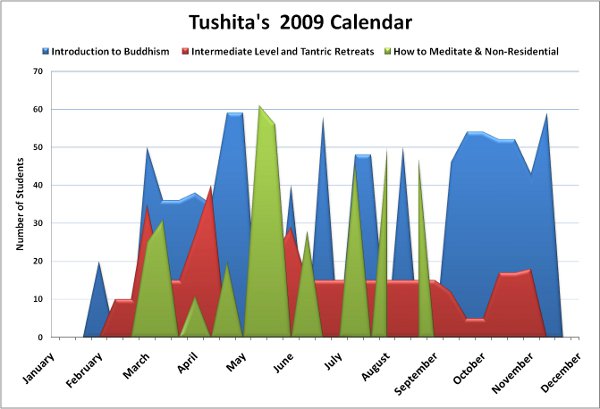
As you can see, we had one course or another going most of the time. On these 38 courses, over the 10 months of the 2009 season, we had a total of 1,305 students!
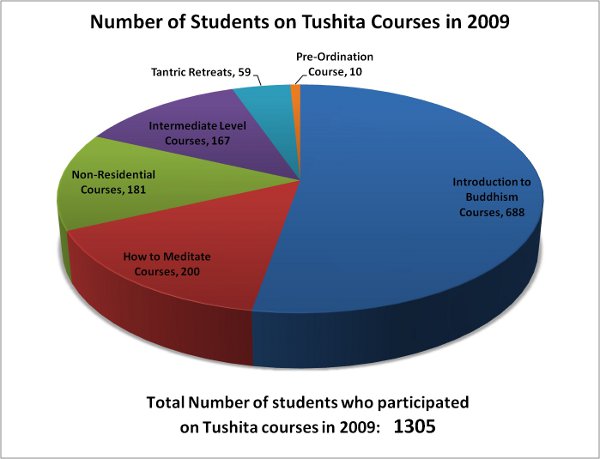
We were interested in how many students participated in each type of course since this was the first year that we had run courses concurrently. It was interesting to note that almost half of our students in 2009 participated in courses other than the 10-day “Introduction to Buddhism”.
This is clear evidence for us that people are looking for different courses at different levels. Hopefully we’ll have sufficient teacher availability in the coming years to keep pace with the demand!
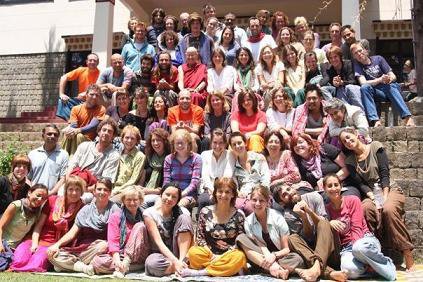
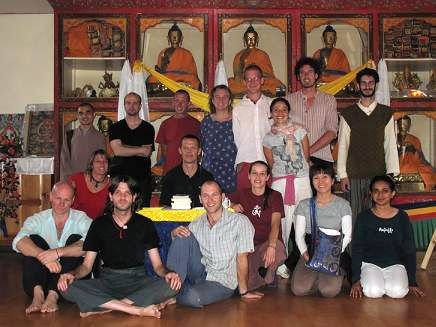
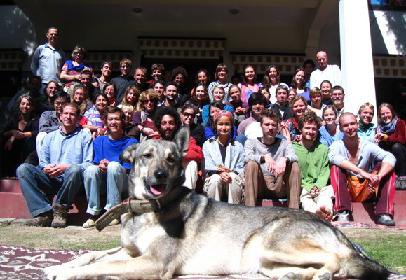
Visitors & Special Guests
Drop-in Visitors
In addition to those who attend our regular courses, here at Tushita there is a consistent flow of drop-in visitors. As well as the daily numbers of passing hikers and those who just come to have a look around, we have regular Movie screenings on Mondays and Fridays at 2pm to which anyone is welcome. We have an excellent library which is well used throughout the year by students and people staying long-term in the local area. We also have an open door to anyone who wishes to attend any of our regular Pujas or use one of our 3 meditation halls for their own practice. It’s impossible to put a figure on the number of drop-in visitors here, but we think it not unreasonable to say that most western tourists who come to Dharamsala/McLeod Ganj come by at least once on their stay.
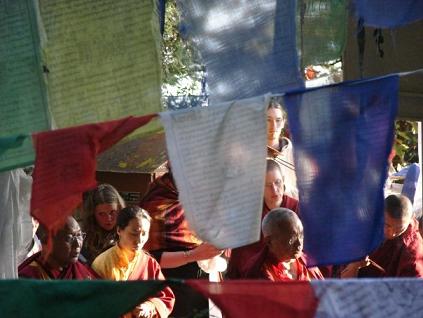
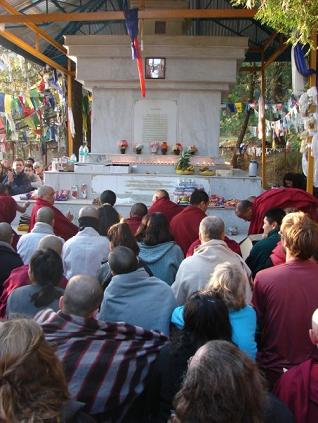
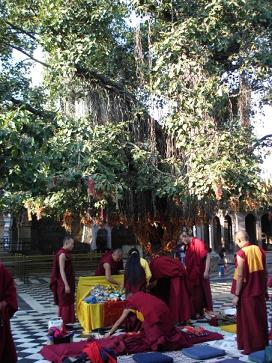
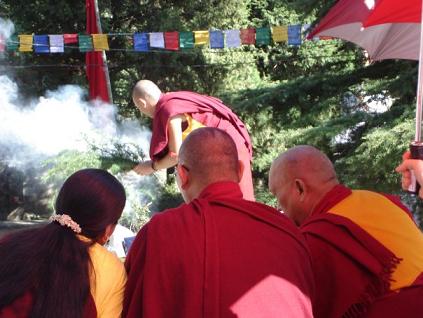
Guest Teachers and Special Events
Lama Zopa Rinpoche stayed at Tushita twice, for around a month each time! First in March/April, and then again in November/December. These visits were packed with pujas, teachings and surprise events, often in the company of Dagri Rinpoche and Khandro-la! You can see many photos from some of the events in March/April here, here, here and here. And photos from events during Rinpoche’s visit in November/December here, here, here and here.
Three Tantric Initiations were held at Tushita in 2009: in May, Dagri Rinpoche conferred the Chenrezig Initiation, principally for those who then went on to do one or more of our annual Nyung Nay sessions, but as is common, many more Buddhist practitioners from the local area attended. Our two other Initiations were for Vajrasattva (in June) and Green Tara (in October). We were incredibly blessed in having both of these ceremonies conferred by Denma Locho Rinpoche. It’s difficult to put an estimate on how many people attended these events. Initiations are particularly popular within the local Tibetan community since they are held in the Tibetan language with English translation and we think it conservative to say that a total of around 400 people attended our 3 initiations in 2009.
Our old friend Bhikshuni Thubten Chodron gave two teachings on “Getting to Know your Mind” on the 17th and 18th of May, with around 200 people in attendance each day, and Jetsunma Tenzin Palmo gave a wonderful talk on the topic of “The Six Perfections” on September 24th. People were sitting on the steps outside because the Gompa was so full! Photos of Jetsunma’s visit are here. Finally, we were honoured to have Geshe Dorjee Damdul (His Holiness the Dalai Lama’s main English translator in India) teach 2 sessions on the October 24 – November 2 “Introduction to Buddhism” course and pictures from these events can be seen here.
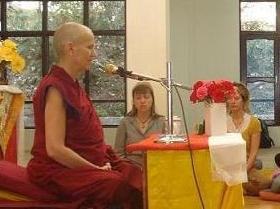
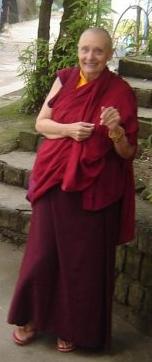
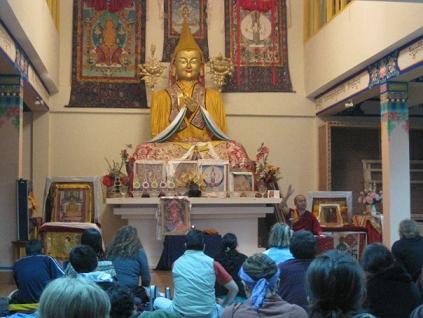
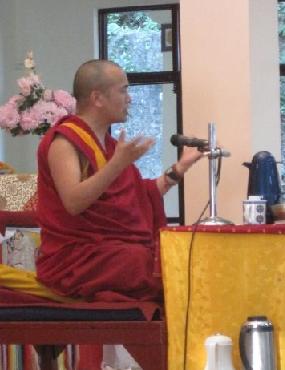
Analysis of Students by Nationality
Our courses always have an enormous diversity of nationalities, but we’d never done a formal study of how many people from each country there were, or which countries were most represented… until now!
Students on our non-residential courses don’t have to provide any passport information to us, so we don’t keep records of their nationality or age. Therefore, the following information is based only on students who participated on our Residential Courses:
|
# |
Native Country of Course Students 2009 |
Number of Students |
| 1 | USA | 178 |
| 2 | Israel | 168 |
| 3 | United Kingdom (UK) | 129 |
| 4 | Germany | 82 |
| 5 | Australia | 81 |
| 6 | India | 60 |
| 7 | Canada | 59 |
| 8 | Holland | 40 |
| 9 | France | 25 |
| 10 | Spain | 25 |
| 11 | Ireland | 19 |
| 12 | New Zealand | 18 |
| 13 | Mexico | 17 |
| 14 | Denmark | 15 |
| 15 | Switzerland | 15 |
| 16 | Finland | 14 |
| 17 | Italy | 14 |
| 18 | Sweden | 13 |
| 19 | Austria | 12 |
| 20 | Belgium | 11 |
| 21 | Japan | 11 |
| 22 | Brazil | 10 |
| 23 | South Africa | 9 |
| 24 | South Korea | 9 |
| 25 | Argentina | 7 |
| 26 | Russia | 7 |
| 27 | Poland | 6 |
| 28 | Portugal | 6 |
| 29 | Vietnam | 6 |
| 30 | Estonia | 5 |
| 31 | Greece | 5 |
| 32 | Slovenia | 5 |
| 33 | Czech Republic | 4 |
| 34 | Luxembourg | 4 |
| 35 | Taiwan | 4 |
| 36 | Slovakia | 3 |
| 37 | Tibet | 3 |
| 38 | Turkey | 3 |
| 39 | Colombia | 2 |
| 40 | Hungary | 2 |
| 41 | Norway | 2 |
| 42 | Singapore | 2 |
| 43 | Ukraine | 2 |
| 44 | Chile | 1 |
| 45 | China | 1 |
| 46 | Georgia | 1 |
| 47 | Kalmykia | 1 |
| 48 | Latvia | 1 |
| 49 | Lithuania | 1 |
| 50 | Malaysia | 1 |
| 51 | Malta | 1 |
| 52 | Nepal | 1 |
| 53 | Palestine | 1 |
| 54 | Romania | 1 |
| 55 | Venezuela | 1 |
| TOTAL Residential Students | 1124 |
So in total, we had 1124 students from 55 different countries on our residential courses in 2009!!
As we had guessed, the USA, Israel and the UK were the most represented countries, but we were interested to find out how this representation was distributed across our range of courses, particularly between Introductory courses (the 10-day “Introduction to Buddhism” and 5-day “How to Meditate” courses) and courses for those with some previous background in Tibetan Buddhist study and practice (Intermediate Level courses and Tantric Retreats).
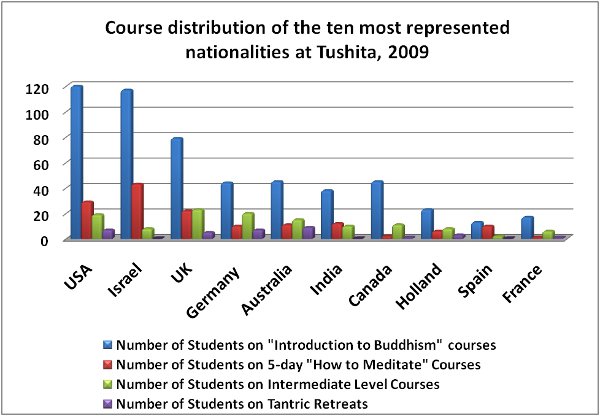
We found that although the top 3 countries had a very high representation in Introductory Level courses, our more advanced courses had a much more even spread of nationalities. There are a few explanations for this: we had a small number of American Student Groups, whose organisers make a Tushita course an integral part of their annual itinerary. This partly explains both the USA’s number one position in the nationality chart, and the representation of students under 20.
In relation to Israel being our second most represented country: it is a very common for young Israelis to travel to India after they have finished their National Service in the Army. The trend is for them to travel in India for periods of several months, at a time when they are in a period of transition and reflection in their lives. These young Israeli citizens are often therefore seeking insight from alternative sources of wisdom, while not actually intending to adopt any fundamental changes in their own religious practices, belief or non-belief. So while many students who attend our Introductory courses go on to take an Intermediate Level course, the difference between our top 3 countries in “Introduction to Buddhism” courses (USA, Israel and the United Kingdom) and in Intermediate Level courses can be explained by there being a large number of travellers who only ever intend to explore introductory Buddhism, in order to gain some techniques and philosophical ideas which may enhance their established lifestyles.
A similar pattern appeared when we looked at the ages of our students:
Analysis of Students by Age
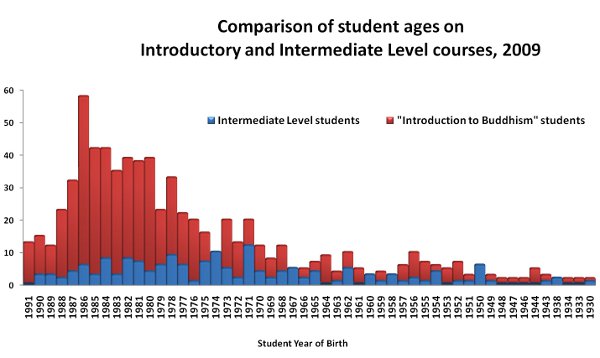
On our “Introduction to Buddhism” courses in 2009, our youngest student was 17 years old, and our oldest was 79; that’s 62 years of diversity! There was a significant peak in Introductory students born in the 1980s, however, while the mix of age groups among Intermediate Level students was much more even, despite representing almost exactly the same age range.
We looked more closely at the age range among “Introduction to Buddhism” students:
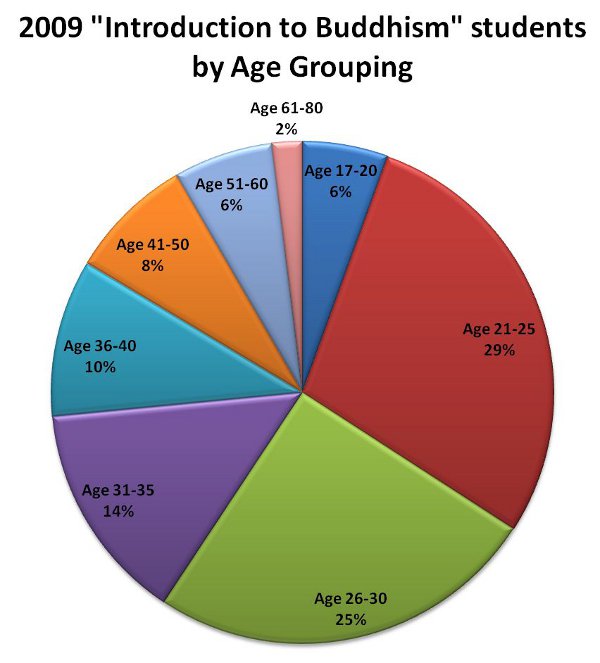
In total, 60% of our “Introduction to Buddhism” students in 2009 were under 30, with another 24% aged between 31 and 40, and 16% aged over 40 (up to age 79!). Although the majority of students on our staple courses are under 40, in recent years we have had a significant increase in registrations from older students. This has created a greater demand for single rooms and higher-quality accommodation, fuelling our plans for a new accommodation block.
By doing a little more analysis, we found that despite the apparent prevalence of under-30s, the average Year of Birth among students on “Introduction to Buddhism” courses was 1977, making the average student in 2009 32 years old; young, but still an age group who generally prefer not to share a dormitory!
This average age increased of course when looking at students on more advanced courses: the average Year of Birth for students on our Intermediate Level Courses in 2009 was 1972, making the average Intermediate Level student 37 years old.
Analysis of Students by Gender
Finally, we looked at how many men & women attended our courses:
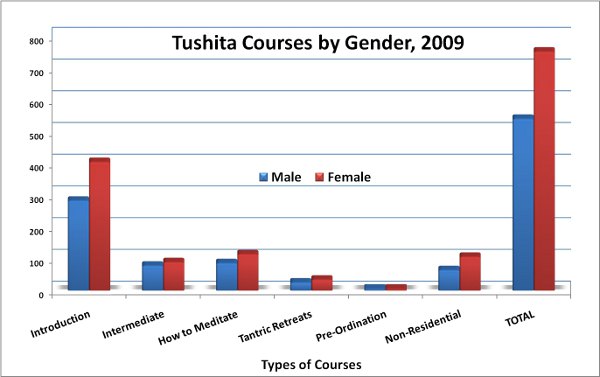
There was no real surprise here, our courses have always had a higher Female representation than Male. But to be specific…
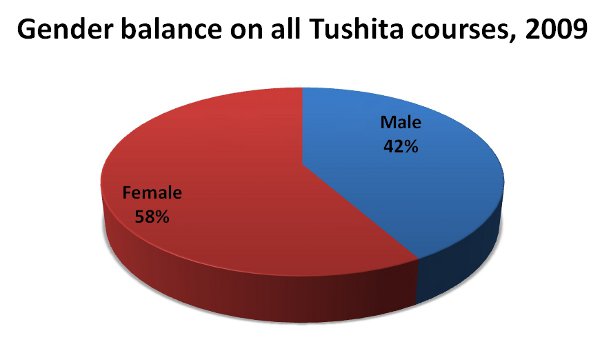
The average “Introduction to Buddhism” Course
Potential students often ask us for details about the make-up of our courses. Of course, there’s no such thing as an average “Introduction to Buddhism” course. Numbers depend greatly on the weather, the season, the International political and economic climate, whether or not His Holiness the Dalai Lama is teaching just before or after the course, so many factors. But as a guide, in 2009 we had 15 “Introduction to Buddhism Courses, with a total of 688 students, making an average of 46 students per course.
The smallest 10-day course had 20 students (in February) and the largest had 59 (in May). However, we were limited by the size of our Meditation Hall in the first half of the year as our Main Gompa was being redecorated. This meant that we had to use a smaller hall and were forced to turn people away during peak season. Now that the Main Gompa is back in action, courses in the future may be larger than during 2009’s high season.
As you can see from the charts above, students on our courses are a diverse bunch, from many, many countries and through a wide range of ages (17 to 79!) . What they had in common, however was that they could understand English to a comfortable degree and were interested in finding out more about the wisdom within Tibetan Buddhism and how to apply this wisdom to their own lives.
Many Thanks
So many thanks to all our Teachers and Meditation Leaders in 2009; Glen Svensson, Ven. Tenzin Chogkyi, Geshe Graham Woodhouse, Sister Jotika, Ven. Rita Riniker, Ven. David Lungtok, Ven. Tenzin Tarchen, Hedwig Bakker, Mark Smith, Tim Van der Haegen, and last, but definitely not least, our Resident Teacher in 2008/9, Ven Jampa Dekyi. Without their generosity, discipline, patience, energy, meditation experience and wisdom, 1305 people would not have been able to explore Buddhist wisdom, while our Guest Teachers provided a rich and diverse texture to the year.
Our local staff keep Tushita functioning in a stable environment and we depend on their loyalty and hard work every year. In addition, Tushita has an ongoing need for willing volunteers. In 2009, many people brought enthusiasm, creativity, initiative and plain old hard work and helped Tushita fulfill her aim of providing a friendly and conducive environment for people of all nationalities and backgrounds to learn about and put into practice the teachings of the Buddha.
Thanks above all go to all our students and visitors. Everybody here at Tushita finds their interest, determination, and openness truly inspiring, we sincerely hope and pray that their experience here will continue to enrich their lives, and in consequence, those of all beings.
Upcoming Events
- Building Inner Strength on July 27, 2024
- Guided Meditation on July 27, 2024 9:00 am
- Movie Day on July 29, 2024 2:00 pm
- Introduction to Buddhism on July 30, 2024
- Introduction to Buddhism on August 13, 2024
- Guru Puja on August 14, 2024 6:30 pm
- Introduction to Buddhism on August 31, 2024
- HH the Dalai Lama teaches locally! on September 6, 2024
- Introduction to Buddhism on September 17, 2024
- Less Desire, Less Pain – The Art of Satisfaction on October 5, 2024
About Tushita
Tushita is a centre for the study and practice of Buddhism from the Tibetan Mahayana tradition. We're located in Northern India, in the forested hills above the town of McLeod Ganj, Dharamsala - the seat in exile of His Holiness the 14th Dalai Lama.
Tushita aims to provide a friendly and conducive environment for people of all nationalities and backgrounds to learn about and put into practice the teachings of the Buddha. With this in mind we offer regular drop-in events and courses on introductory Buddhist philosophy and meditation, as well as intermediate level courses and group retreats for more experienced students.
Opening Hours
February to November
Monday - Saturday
9:30 - 11:30am
a break for lunch and then...
12:30 - 4:00pm
Closed Sundays

